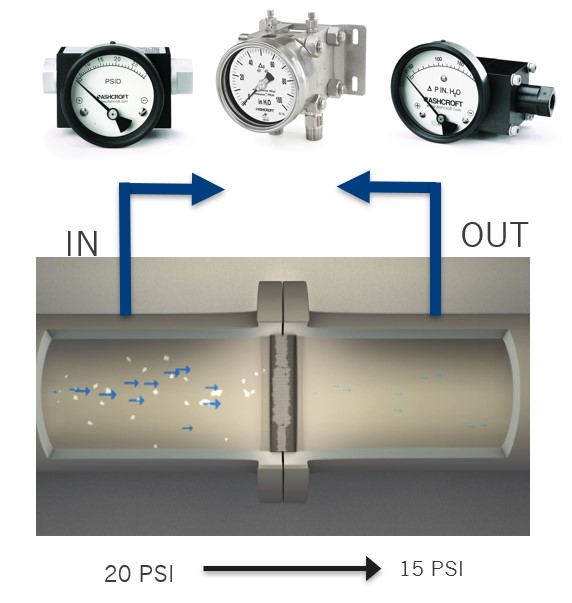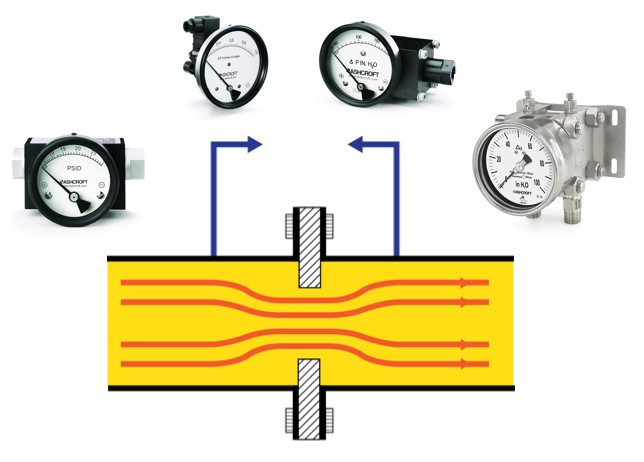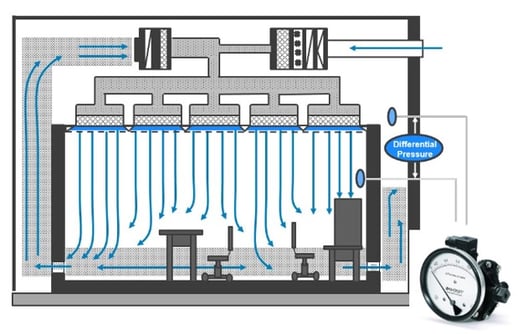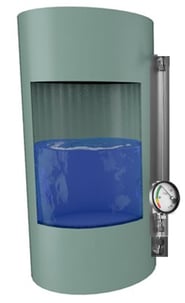
By:
Dave Dlugos
Product Technical Leader
Published on:
February 7th, 2024
Subscribe now and get the latest blog posts delivered straight to your inbox.
What is a Differential Pressure Gauge?

By:
Dave Dlugos
Product Technical Leader
Published on:
February 7th, 2024

A differential pressure gauge measures the difference in pressure between two points in a system and presents the subsequent differential pressure directly on a single gauge dial.
Ashcroft has specialized in pressure instrumentation since 1852. As a leader in our field, we are often asked to provide information to individuals looking for a foundation of knowledge on this subject and more.
Read on to learn where basic definitions related to differential pressure, where the gauges are used, how they work, and common applications. When you're done reading, you will also find additional resources that may interest you.
Basic definitions related to differential pressure.
Before we get started, here’s a quick review of a few important definitions:
- Differential Pressure: The difference between two pressure points in a system.
- Static Pressure: The maximum allowable working pressure (MWP or MAWP) in a system.
- Single-Sided Static Pressure: The maximum pressure that can be applied to one side of an instrument while the other side is open to the atmosphere.
Figure 1: Differential pressure example.
What are common applications for a differential pressure gauge?
Most differential pressure gauges are used for monitoring liquid or air pressure in chemical and water treatment facilities, pharmaceutical plants, hospitals, petrochemical systems, power plants and other industries. Here are a few of the most common applications:
Filter/Strainer applications
If your operation requires close filter monitoring or pump performance, for example, you’ll want a visual indicator of the difference in pressure between two points in the system. Monitoring pressure in these applications is extremely important. Here why:
- These systems commonly use filters and strainers to obstruct the flow through the pipe and capture any solids and particulates.
- As the filter becomes clogged, it won’t function properly which could allow contaminants to escape into the process.
- When this happens, the pressure on the downstream side will drop and differential pressure will increase indicating the filter needs to be changed.
- By placing taps before and after the filter and connecting a differential pressure gauge operators will be able to see the difference in pressure between the two sides. Once a pre-determined threshold is reached, the operator will know that it is time to service the filter.
Figure 2: Differential pressure filter strainer with Ashcroft® differential pressure gauges 1130, 5504 and 1132.

Flow measurement applications
A differential pressure gauge can also be used to measure the flow in a system. Flow is linear to the square root of the differential pressure. The scale has a square root function calculated, so the dial is a linear flow measurement.
The Ashcroft© 1130 Differential Gauge, for example, will measure the pressure drop across the orifice plate using the differential pressure and square root to measure and indicate the flow rate.
A slow flow may indicate a clogged line or other issue, while a fast flow may indicate that your check valve is set incorrectly. In any case, flow changes in your process require immediate attention.
A dual-scale dial can be used for both differential pressure and flow rate.
Figure 3: Differential pressure flow measurement with Ashcroft® differential pressure gauges 1130, 1134, 1132 and 5504.

Static air pressure measurement applications.
For airflow measurement in a heating duct, a pitot tube is commonly used with a differential pressure gauge. The main difference between pitot tubes and orifice plates and venturi tubes is that an orifice plate or venturi tube measures the full flow in the pipeline. The pitot tube measures the flow at only one point in the flow stream. Once again, in this method, flow is linear to the square root of the different pressures.
Air duct static pressure measurement with a static sensor or simple tap in a duct. For air flow measurement a Pitot tube is commonly used. Flow is linear to the square root of the different pressure. The Ashcroft® 1134 is a good option for a local indication for either application.
Figure 4: Differential pressure static air with Ashcroft® differential pressure gauge 1134.

Clean room and isolation room applications.
A clean room provides a controlled environment to eliminate contamination. Maintaining pressure in the clean room is extremely critical. If pressure is too low containments can enter from adjacent areas if a door is opened.
The Ashcroft 1134 Differential Pressure Gauge is a good option for providing local indication with switching capabilities to monitor or improve airflow.
Figure 5: Differential pressure clean room and isolation room with Ashcroft® differential pressure gauge 1134.

Non-vented pressurized tank-level applications.
In a non-vented tank, liquid levels are directly proportional to the differential pressure. Optional vertical mounting with vertical dial, and color bands can enhance this cost-effective method of measuring liquid level of cryogenics or other fluids utilizing any of the 113x diaphragm gauges. They can be equipped with switches for tank-level alarms or pump control. Plus, they can be used on an open tank by leaving the low port vented to the atmosphere.
Figure 6: Differential pressure non-vented pressurized tank application.

Ready to go beyond the basics of differential pressure gauges?
Now that you have a basic foundation of differential pressure gauges and how they work, you likely have more questions. Here are a few helpful resources to help you take the next step in building your knowledge on the subject:
- Product Comparison: 5503 vs. F5504 Differential Pressure Gauges
- Why use a Differential Pressure Gauge to Measure Flow
Or, to speak with someone directly, feel free to contact one of our product experts with any questions you have. In the meantime, check out our pressure gauge selection tool to help you find the best instrument for your needs. 
Dave Dlugos, Product Technical Leader
Dave Dlugos has a BSEE degree and 40 years of experience in the measurement industry performing design engineering and product management. He has earned 4 U.S. patents and joined Ashcroft in 2007, currently as the Product Technical Leader. He is a senior member of the International Society of Automation (ISA), past ISA District 1, Vice President, past ISA water and wastewater division board member and the past President of CT Valley ISA Section.



























